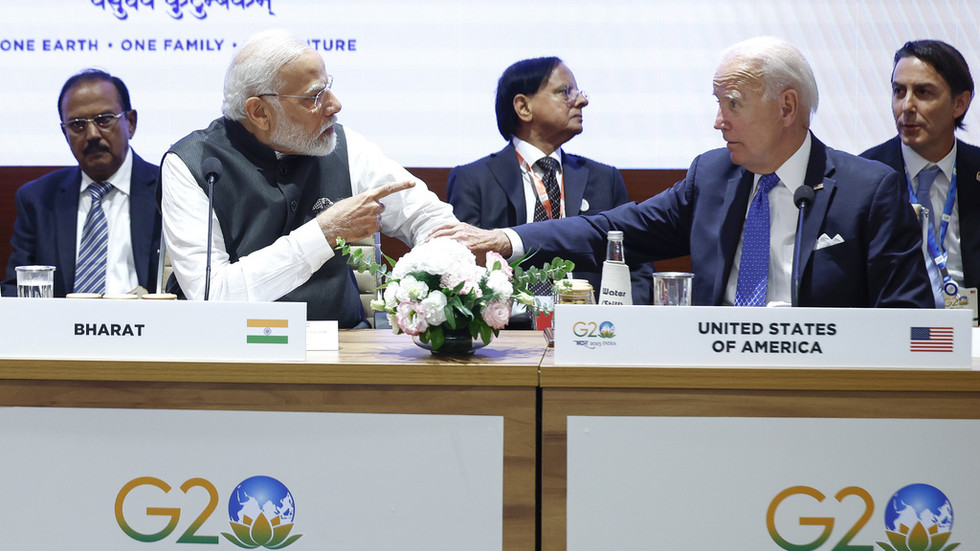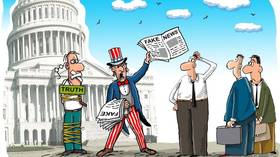
The West has tried to outshine Beijing’s grand trade route multiple times, but can’t muster the will to do it
By Timur Fomenko, a political analyst

US President Joe Biden, right, and Indian Prime Minister Narendra Modi attend Partnership for Global Infrastructure and Investment event on the day of the G20 summit in New Delhi, India, Sept. 9, 2023. © AP Photo/Evelyn Hockstein, Pool
On the sidelines of the G20 Summit at the weekend, the United States and India unveiled proposals for what has been termed the India-Middle East-Europe Economic Corridor (IMEC) with the backing of the United Arab Emirates, Saudi Arabia, Israel, and Jordan, as well as officials from the EU.
The project, billed as an alternative to China’s Belt and Road Initiative (BRI), seeks to build a commercial route from India through to Europe via the Arabian Peninsula, Israel, and then the Mediterranean Sea. Unsurprisingly, the project’s significance was inflated by the press as “historic” and a “blindside” challenge to Beijing that would doom China’s own mega-infrastructure project.
But such conclusions are misleading, for many reasons. First, not every participant in this new initiative is squarely opposed to China and sees it, as the US does, as a zero-sum game. The Arab countries, including Saudi Arabia, the UAE and Jordan, are not anti-Beijing at all and are part of the BRI themselves. These countries, seeking to diversify their economies from dependency on oil revenue, are seeking new options to consolidate their wealth and thus courting large-scale foreign investments, including from China itself. They want to make themselves the “crossroads” of the world, they do not see such a project through the lens of containment or even geopolitical rivalry, but as creating more benefits for themselves. If Saudi Arabia can get Chinese and Indian cargo going through their country, that’s a double win – it never had to be an “either-or” arrangement for Riyadh.

Read more
Second, parts of this new route are co-opted from China itself. The Haifa Port in Israel was, until recently, mostly under China’s control (India’s Adani Group acquired 70% of the stake in July), while Piraeus Port in Athens was controlled by Chinese shipping company, Costco.
The railroad infrastructure linking Greece with Central Europe is also part of the BRI. Another Chinese-owned commercial port exists on that same route in the Indian Ocean – Gwadar Port in Pakistan, which is part of the China-Pakistan Economic Corridor (CPEC). This means that China itself can use multiple parts of the proposed transport route, and the IMEC project does not really undercut Beijing to the extent it’s being portrayed – and all of the co-opted countries would be pretty happy for that.
Third, this project could end up in the growing graveyard of pledged, and failed, BRI alternatives, which come at a rate of approximately one per year. It wasn’t that long ago that the US and its allies in the G7 were launching Build Back Better W (B3W), or the Global Partnership for Infrastructure Investment, or the Blue Dot Network. None of these projects have the coordinated hierarchical superstructure that the Chinese state does, which allows projects to be cooperated and rolled out at breakneck pace, nor do they have the readily accessible financial resources to take off.
If China seeks to build a high-speed railway, for example, the Communist Party can coordinate a bank to fund it, a railway company to build it, and a supply chain to stock it, all in one organized motion. The US does not have the power to do that, unless of course it comes down to military and defense spending, such as the bottomless pit of aid to Ukraine, and therefore is unable to compete. All other spending in Washington is part of the never-ending political battle in the Congress, where every single non-military penny must be fought for, tooth and nail, in a serious process. It’s why its own national infrastructure is increasingly shoddy, and, to use the above example for comparison, American high-speed railways remain underdeveloped by generous definition and non-existent compared to China.

Read more
Finally, the IMEC is tiny compared to what the BRI aims to achieve. While IMEC wants to connect the Middle East to the Indian subcontinent (which also benefits China), the BRI has been working on not just one, but multiple economic corridors all over the planet. This includes comprehensively connecting the Eurasian landmass through huge railways spanning Russia, Central Asia and Mongolia, making it possible for a train from Shanghai to arrive in London, but also creating a new route to the sea through Pakistan (CPEC), connecting South East Asia by land through new railroads going through Laos and into Thailand, as well as a route which spans West Asia through Turkey and another Indian subcontinent foray with the China-Myanmar Corridor.
In conclusion, the US has been desperate to rival the Belt and Road Initiative, but has never been able to produce anything of the same scale or vision, all the while repeatedly ignoring the reality that transcontinental infrastructure routes are not “zero-sum games” because their results ultimately benefit everyone, which in China’s perspective has always been the focus of the BRI itself as a “win-win” initiative. Despite that, each new branded “alternative” comes with the same hype that “this time” China’s project has met its match. No, it really hasn’t, but thanks for creating a new route which Chinese cargo can use in the meantime.
The statements, views and opinions expressed in this column are solely those of the author and do not necessarily represent those of RT.




